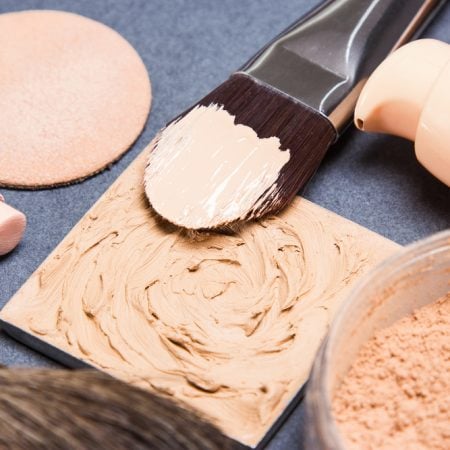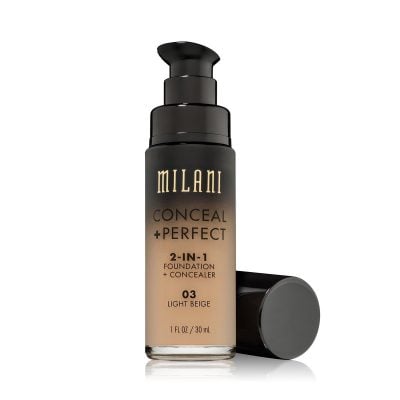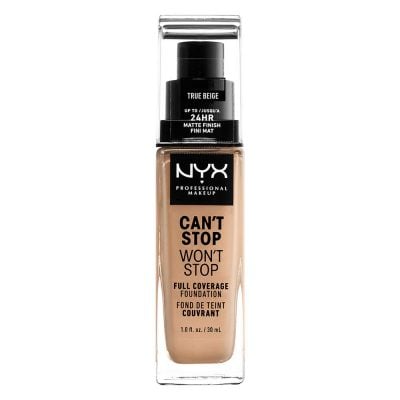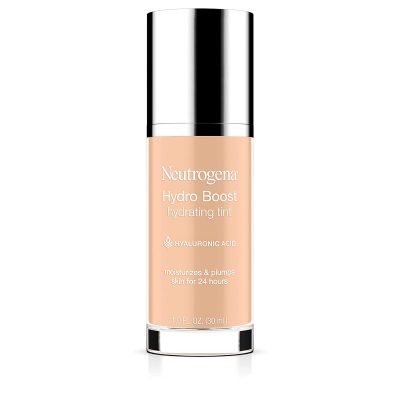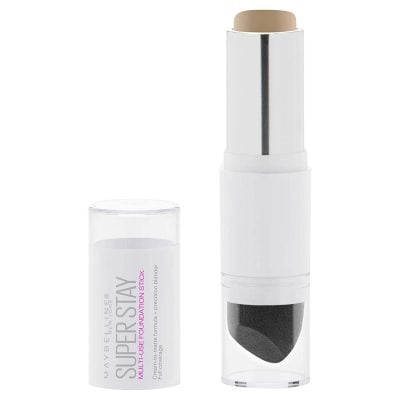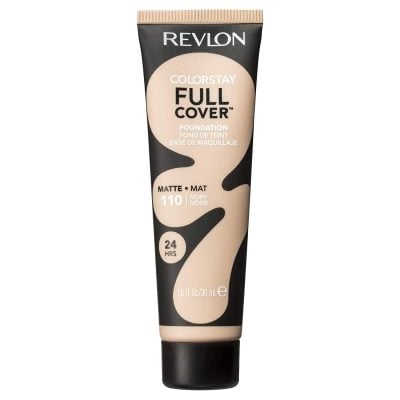Having to jump through hoops to put a face on just isn’t fair. One lapse in diligence, one minute change in a once-trusted formula, and a storm of itchy welts can run across your skin for weeks.
If it’s any consolation, the third of the population that has skin allergies to cosmetic ingredients doesn’t account for the millions of people who experience irritation due to general and acquired sensitivity. You are far from alone in your struggle.
- Save your Sensitive Skin With The Right Foundation
- Top 10 Best Foundations for Sensitive Skin 2025
- 1. Best Overall Foundation: Milani Conceal + Perfect 2-in-1 Foundation
- 2. Best Premium Foundation: Nyx Professional Can’t Stop Won’t Stop
- 3. Best Powder Foundation: L’Oreal Paris True Match
- 4. Best Budget Foundation: Maybelline Fit Me Matte + Poreless Liquid Foundation
- 5. Best Portable Foundation: Wet N Wild Focus Stick
- 6. Best Foundation for Symptom Relief: Mineral Fusion Pressed Powder Foundation
- 7. Best Moisturizing Foundation: Neutrogena Hydro Boost Hydrating Tint
- 8. Mineral Fusion Liquid Foundation
- 9. Maybelline New York Super Stay Foundation Stick
- 10. Revlon ColorStay Full Cover Foundation
- Complete Guide to Foundations for Sensitive Skin
- Final Thoughts
Save your Sensitive Skin With The Right Foundation
There are a number of factors involved in selecting a foundation that determines if it’s the right one for you. Before we get to our list, we’ve included a breakdown of what is most helpful to look out for in each foundation.
Foundation Type
There are several types of foundation that can be suitable for sensitive skin, but each has its own advantages and disadvantages that should be considered carefully.
Liquid Foundation: Liquid foundations come in tubes or bottles. They can be lightweight or heavy, and are often ideal for applying multiple layers for maximum coverage. They’re also great for blending, ensuring that they match your skin tone perfectly.
Powder Foundation: Powder foundation typically comes in small, portable containers that make it great for touch-ups on the go. It’s not great for dry skin, though, so be careful not to overapply if that’s you.
Cream Foundation: Cream foundations are thick, but have the benefit of also serving as a moisturizer. They’re great for full-coverage looks.
Mineral Foundation: Natural mineral foundations are a great choice for most types of sensitive skin. They’re generally non-irritating and provide good coverage—but they are a bit harder to find, and they can look a bit powdery if you don’t use the right brush, so be sure to read our guide to the best foundation brushes on the market today.
Skin Type
Your skin type does a lot to determine which foundations will work well for you, so be sure to match your needs to the perfect product in order to keep your skin looking and feeling its best.
Normal Skin: This type of skin isn’t too oily or too dry. You rarely have sensitivity to products, and your complexion is all over pretty even.
Dry Skin: If you have dry skin you will usually have an all-over redness or roughness. This can also be accompanied by almost no visible pores and less elasticity of the skin.
Oily Skin: Oily skin tends to be shiny. You usually have larger pores with this skin type, and are more prone to both blackheads and breakouts.
Combination Skin: This is a combination of both oily and dry skin occurring in different areas of the face. You might also have a shiny complexion or overly dilated pores.
Sensitive Skin: Sensitive skin is easily irritated. It can feel like burning, itchiness, or look red or dry very quickly when it comes into contact with certain products like fragrances or synthetic compounds.
Suitability for Sensitive Skin
When choosing a foundation for your sensitive skin, be sure to look for ingredients that won’t harm or irritate you. This is easier said then done, so as a quick primer look for things like aloe vera, allantoin, and glycerin, while trying to avoid harsh fragrances, alcohol, and parabens. There’s more to it than that, though, so be sure to read our guide to all of the ingredients to seek out (and avoid) below.
Top 10 Best Foundations for Sensitive Skin 2025
1. Best Overall Foundation: Milani Conceal + Perfect 2-in-1 Foundation
Editor’s Rating:
Quick Facts:
- Type: Liquid
- Shades: 41
- Skin Type: Dry to slightly oily
The balance between suppleness and staying power we’ve ached for is right here. It’s exceptionally smooth and light going on but provides full coverage, needing just one or two pumps to get the job done. It treats dry, sensitive skin the best, but it won’t fail you unless you’re more than moderately oily. We wouldn’t go as far as calling it liquid silk, but it spreads very easily. If you’re also using it as a concealer, it gives you just enough time to build on your problem areas before it sets. It almost feels like something you’d steal from a witch’s cauldron.
A wide array of shades are available with good tapering between light and dark selections. It does stumble on its way towards its lightest shade, 00AA-ivory. It has a noticeable warm yellow tinge that may leave pale or older skin wanting. If you look hard, you can spot hints of it in other shades as well. The good news is that It’s cheap enough to experiment with mixing if you love it but can’t quite find a fit.
Milani Conceal + Perfect will have your back for most of the day, especially with a light primer. A little sweat and water won’t ruin it, but it doesn’t compete against heavier formulas like the Nyx Professional Can’t Stop Won’t Stop marketed for their resistance to activity and doesn’t ward against UV rays.
We recommend application with a brush or dry beauty blender. A wet blender will absorb quite a bit of it, leaving less for your face, probably due to its fluffy texture.
Irritation and Relief
In most cases, it’ll hide inflammation and won’t make your skin freak out with prolonged use. It’s very good for sensitive skin despite being marketed towards general use. Glycerin and glycerin variants like Butylene Glycol stand ready alongside a small dose of Allantoin to produce a fresh feeling as it sits on your face. It won’t serve as the most powerful salve, but it can take the edge off.
Milani Conceal + Perfect’s only hang-up its phenoxyethanol content. It’s a preservative that’s about as dense as most commercial parabens and has been evaluated by the European Scientific Committee on Consumer Safety as an ingredient that doesn’t cause too many problems, but a small number of people may experience minor irritation when exposed to it. Severe allergic reactions are very rare. In cosmetics, it prevents the buildup of bacteria (which tends to cause skin irritation itself).
Pros
- Moisturizes dry skin
- Contains both glycerin and allantoin
- 2 in 1 product
- Efficient coverage. You’ll fetch the same results as other formulas using less per application
Cons
- Phenoxyethanol can irritate a select group of people
- The yellow tinge may be too harsh for the lightest skin types
- Not the best for wet blender application
Editor’s Rating:
Quick Facts:
- Type: Liquid
- Shades: 45
- Skin Type: Normal to oily
It’s a bit more expensive than most of the other members of this list, but you’re paying for a long-lasting, full coverage foundation that boasts strong water and activity resistant properties. Like most matte formulas it dries to combat oily skin, but it’s not so severe as to prevent normal skin types from using it.
It goes on soft, though you may experience some resistance while spreading it. This is normal for most full coverage foundations.
The in-between variation is tightly packed and favors a cooler tinge, which may be a good or bad thing. Even the warm and neutral undertones seem a little cold.
You may want to consider a dense, soft brush with this one to minimize product loss. Blender application doesn’t present significantly different results.
Irritation and Relief
Can’t Stop Won’t Stop has phenoxyethanol and isobutane, both of which may cause light to moderate skin irritation, though the rate of incidence is rare. Avoid it if you’re allergic to either substance and try something ultra-gentle like L’Oreal Paris True Match.
It has a good amount of glycol and less tocopherol, a vitamin E product that can help soothe your skin and reclaim some ground lost to sun exposure.
Pros
- Long-lasting
- Super tough
- Has glycol and tocopherol to relieve irritation
Cons
- Can feel a bit thick
- Two moderate irritants: phenoxyethanol and isobutane
- Not as affordable as other options
3. Best Powder Foundation: L’Oreal Paris True Match
Editor’s Rating:
Quick Facts:
- Type: Powder
- Shades: 11
- Skin Type: Dry to moderately oily
L’Oreal Paris True Match is light, buildable, and very discrete on skin types it matches. It lasts almost as long as Milani Conceal with about as much resistance to wear unless you have very oily skin. The limited shade choice may leave you frustrated (you can pull on the attached brush until it rips in such a case), though. It’s moderately priced compared to other members of this list.
Fair, tan and pale skin won’t have too much trouble finding a color match, but anyone darker than a rich cocoa won’t find joy here. Because all the variants lean towards a neutral tinge, mixing the formula with itself won’t correct this—instead, you’ll want something with more variation like the Mineral Fusion Pressed Powder Foundation.
We don’t love the brush that comes with it. It performs just good enough, but you’re better off applying it with something less coarse and more easy to clean. Extraction and application can feel like work at first, but as long as you don’t make brisk strokes and tap excess powder back into the container, it won’t cause a mess. Be gentle, it’s worth it.
Irritation and Relief
The formula makes up for all the trouble it can be to get on your face by a million. It combines aloe and tocopherol to provide quick soothing action for dry or distressed skin, the kaolin gently mattifies oil without interfering with moisture or producing an unnatural shine. It also has titanium dioxide for light sun protection, weighing in at SPF 19
Unless you have a specific allergy to its very short ingredient list, it won’t cause and is highly unlikely to exacerbate skin irritation.
As a powder with metal content, it can cause respiratory issues if you rush. We recommend using a slightly damp beauty blender to get any loose particles to chill out.
Pros
- Blends exceptionally well with the shades it supports
- SPF 19
- Provides very decent relief for irritation symptoms
- A simple, stable formula that has little chance to provoke your skin
Cons
- Not as cost-efficient as heavier formulas
- Poor shade variation on the darker side
4. Best Budget Foundation: Maybelline Fit Me Matte + Poreless Liquid Foundation
Editor’s Rating:
Quick Facts:
- Type: Liquid
- Shades: 40
- Skin Type: Oily
This creamy smooth formula is dermatologist tested to be non-irritating to most sensitive skin types. It doesn’t go on as light as Milani Conceal but offers medium-ish buildable coverage. Blending and layering can be done quickly with minimal fuss, and Its mattifying properties don’t disappoint people on the oily side. You won’t shine or look like a zombie extra that wandered too far from the set after it settles on your face.
We won’t lie though, if you have dry skin, this isn’t for you. It’ll draw water away from you like it’s trying to drain a well. Maybelline New York does offer a formula variation for dry skin, but it had far too many irritants to justify a place on the list.
As far as shading goes, the variety and in-betweens are on par with Milani Conceal, but this formula doesn’t have the same off-color tinge problem. The 102 Fair Porcelain shade is suitable for pale skin.
You should be careful when you extract it from the container, especially if you’re used to buying thicker formulas as it can come out faster than expected. Despite the consistency, your beauty blender won’t be as grabby with this one while wet so you can sponge it out damp or dry, though results are better with a brush.
Irritation and Relief
We almost put this formula in the number two spot, but when we found parabens in the ingredient list, it broke our hearts a little.
As previously mentioned, the paraben content may upset those with more severe skin conditions, even with the formula’s dermatologist backing. If you can’t claim any benefit from Maybelline Fit Me Matte’s otherwise stellar profile, consider using Milani Conceal or Can’t Stop Won’t Stop if your skin is too oily to sneak in the former.
Pros
- Excellent for oily skin
- Affordable medium coverage choice
Cons
- Contains parabens
- Dry skin types can’t get away with using it
- Builds very easily
- Has a strong color profile
5. Best Portable Foundation: Wet N Wild Focus Stick
Editor’s Rating:
Quick Facts:
- Type: Stick
- Shades: 20
- Skin Type: Slightly dry to oily
A few light dots down the center and either side of your face with this formula will get you a good medium coverage that stays on shade even after a few hours in the sun. Despite its form, Wet N Wild Focus Stick manages to be soft enough for reasonably easy blending. You can use a sponge or a brush for this one, but it’s recommended that you wet both. The color profile is generally neutral and supports a decent number of shades unless you really need something warm, which Milani Conceal can provide.
You may be tempted to dab yourself with the full face of the stick. Don’t. Perform your initial application around the edges until you know how much you’ll need to reach your desired coverage and use your preferred blending method. It doesn’t set too quickly and can be deceptively efficient.
Irritation and Relief
The merits specific to sensitive skin begin and end with its stable nature. The only major irritant it contains is phenoxyethanol, but the concentration is low enough to be near the bottom of the ingredient list. It has some cleansing and skin softening properties, but they’re mild at best. We’d be more “meh” about the product if it didn’t come so cheap.
Pros
- Won’t cause a reaction in most users
- Fast and simple to apply
- Cost-effective and affordable
- Fits a wide range of shades despite a smaller selection
Cons
- Not as soothing as other options
- Might not have enough yellow tint for some
6. Best Foundation for Symptom Relief: Mineral Fusion Pressed Powder Foundation
Editor’s Rating:
Quick Facts:
- Type: Mineral
- Shades: 24
- Skin Type: Moderately dry to oily
A very fine, gentle mineral formula that carries an EWG verification for safety. It offers buildable coverage similar to L’Oreal Paris True Match, but is less prone to make a mess and far easier to apply. It’s more likely to help dry skin along than ruin it, but it works better on oily skin. When something does go wrong, it’ll typically flake around wrinkles and the nose. A hydrating finishing spray or damp blending pass can go a long way in preventing this.
The color spread for this formula is pretty neat, darker shades lean cool while lighter ones are warm, which would make it a good candidate for mixing if it wasn’t so expensive.
Speaking of the price, it’s a little up there. You’re only getting nine grams, and its light nature also means you’ll be using more of it if you need to achieve full coverage. You can use a sheer dusting of Mineral Fusion Pressed Powder to finish the look of a cheaper liquid foundation if you want to be economical and effective, but you won’t feel the skincare benefits that are its best selling point as intensely.
Irritation and Relief
By far, this formula provides the best soothing effect on sensitive skin, aiding dry, oily, and chronically afflicted types. Almost every ingredient confers some benefit to sensitive skin, there are various tea extracts, aloe, cucumber, licorice root, and non-irritating vitamin sources that act as much as a balm as it does a foundation. If you need a makeup that will take care of you, and find that the others are too weak, Mineral Fusion Pressed Powder may be worth the plunge.
Even with the EWG verification, if you’re allergic to licorice root you’ll want to pass on it, Mineral Fusion Liquid Foundation might serve as an alternative if you don’t like powder.
The metal content is low and less likely to cause respiratory irritation, but you should still follow safe practices when applying.
Pros
- Powerful relief
- Decent wear resistance
- Easy to use
Cons
- Most expensive option on the list
- Other relief providing formulas may provide the fix you need for less
7. Best Moisturizing Foundation: Neutrogena Hydro Boost Hydrating Tint
Editor’s Rating:
Quick Facts:
- Type: Liquid
- Shades: 10
- Skin Type: Dry to normal
As a skincare company, Neutrogena has a history of catering to customers suffering from irritation since 1930, their foray into the realm of makeup has been generally well-received.
With Neutrogena Hydro Boost, you’re getting a very light foundation for a middle of the road price. It has a small absorbent applicator that will help you control the amount of product you use, but you may find yourself going in for several dips. The coverage it provides is spotty even among other formulas bearing the designation, though it’s not horrible.
Dry skin will appreciate it more than oily or even normal skin, as it does do a good job of providing sufficient hydration. The life of any canvas created with it will be cut by hours if you expose it to the elements or perform strenuous activity, though.
The available shades are neutral-warm, lack real variation, and don’t work all too well for the darkest or lightest skin tones.
Irritation and Relief
The lack of shade variation and lightness of this formula is honestly a shame; it has very decent soothing properties with only a small amount of phenoxyethanol. That being said, it’s not especially diverse, with glycerin and glycol being the only strong agents present in a significant concentration. Pick it if you have trouble with the other options or have a lot of faith in Neutrogena.
Pros
- Light
- Provides good symptom relief
- Great for dry skin
Cons
- Hard to color match
- Some may consider it too light
- Better options are available for value and strength
8. Mineral Fusion Liquid Foundation
Editor’s Rating:
Quick Facts:
- Type: Liquid
- Shades: 17
- Skin Type: Normal to oily
We want to like this one more. Really, we do. It’s easy to apply and provides a lighter form of matte suitable for oily skin types that want to avoid the feeling of wearing makeup as much as possible. The formula just doesn’t stay on as long as you want it to when subjected to sweat and the elements which doesn’t bode well for it.
Irritation and Relief
The very same praises for this formula’s powdered analog can be sang for Mineral Fusion Liquid Foundation, though not at a crescendo. The soothing mixture is similar, but there’s less licorice root to be found. We aren’t going to recommend the unlucky few that are allergic to the powdered form to use this one as an alternative, though.
Rosehip is present in this formula, which may provoke a rare mild-to-severe reaction, but it works great for aging and eczema afflicted skin.
Pros
- Rosehip can benefit aged and distressed skin
- Easy to apply
- Good for oily types that want a lighter feeling
Cons
- Still contains enough licorice root to cause a reaction
- Rosehip is sometimes a moderate allergen
- Lacks staying power
9. Maybelline New York Super Stay Foundation Stick
Editor’s Rating:
Quick Facts:
- Type: Stick
- Shades: 8
- Skin Type: Normal to oily
The primary reason for this formula’s low placement is its lack of variation, there’s just eight available shades on Amazon; the range is narrow, favoring light or pale tones.
If you do manage to find a proper color fit, you may just love it. It isn’t stiff and makes for a full matte canvas that lasts for a long while.
The attached sponge blender works well with the formula when dampened, letting you spread it with little resistance.
Overall, the Wet N Wild Photo Focus Stick works much better and accommodates a wider range of skin types and tones, but Maybelline beats it in terms of endurance and has fewer ingredients.
Irritation and Relief
If you’re looking to prevent breakouts before soothing them, you may appreciate this formula over the Wet N Wild Photo Focus Stick as it boasts greater neutrality but contains even fewer soothing agents. The ingredient that does the most work for you here is a moderate concentration of beeswax which may provide a bit of hydration and promote natural skin regeneration.
Pros
- Unlikely to irritate
- Stays on strong
- Affordable
Cons
- Very few soothing agents
- Lack of color choices
10. Revlon ColorStay Full Cover Foundation
Editor’s Rating:
Quick Facts:
- Type: Cream
- Shades: 16
- Skin Type: Oily
Oily skin needs hydration, too! Revlon ColorStay can take care of that for you with a dense formula that doesn’t have trouble staying put on oily skin. Despite its moisturizing properties, it can be a real hit or miss with dry skin types, leaving patches if it fails.
It can feel like a mask after it sets, especially as time drags on, but this is typically a hint that says you’re using a bit too much. It can feel like you need more than you do with how easy it is to spread, but you should apply a minimal amount and work your way up.
We aren’t super excited about the shade variety, but most people with pale and fair skin won’t encounter any problems. The variation gets jumpy after it hits Sand Beige, though. You might have to do a little mixing to make up for the range deficit.
The formula is slightly lighter when applied with a brush, which is the recommended method. Preserving thickness with a dry blender isn’t likely to be necessary.
Irritation and Relief
Besides glycerin, Revlon’s primary soothing agent is salicylic acid, a double-edged sword. It’s used commonly as cleanser and exfoliant, so it may help you if your irritation is caused by grease and impurities, but if your skin is thinning, it has a chance to make things worse.
Pros
- Can be cost-effective if you get the usage amount right
- The salicylic acid can soothe skin that tolerates it
- Strong moisturizing properties
Cons
- Limited in-between shades for darker and even peach skin
- Not very forgiving if overapplied
- Contains phenoxyethanol and high concentrations of salicylic acid
Complete Guide to Foundations for Sensitive Skin

Proper research and an ounce of suspicion will be your best friend as you strive to manage your sensitive skin. You’ll want to bat known irritants away with a stick while keeping an eye out for ingredients that’ll soothe symptoms or prevent them from rearing their ugly heads in the first place.
What Causes Skin Sensitivity?
Sensitivity reactions, called contact dermatitis in the clinical world, comes in two primary forms: irritant contact dermatitis and allergic contact dermatitis. You can have one or both and differentiating between the two can be difficult without the aid of a dermatologist. Redness, swelling, and rashes are shared symptoms.
Irritant Contact Dermatitis
Irritant contact dermatitis is generally caused by a gap opening up in your natural defenses. Working in an industry that exposes you to excessive heat, sunlight, wind, or harsh chemicals weakens your skin barriers and inhibits the healing process. A formula may suddenly make you break out when you had no trouble before, but progression is more likely to be gradual until it becomes blatant.
You’ll have better options to control the severity of your symptoms if allergies aren’t the issue. When you give your skin time to recover from its ordeals, your condition is likely to improve. In the meantime all of the foundations on our list, including our top overall pick should prevent any reaggravation of the irritation.
Allergic Contact Dermatitis
Allergic contact dermatitis and the more persistent skin problems like eczema and rosacea are unfortunately the results of genetics. Changing your environment might be less effective at reigning things in.
You likely know all too well if you have the latter, but mild cases of the former tends to heal more slowly and may stay around for weeks after you cut the offending allergens out of your life.
Several skin conditions are associated with autoimmune disorders; if you have asthma or a food allergy, you’re more likely to be afflicted.
A symptom-relief foundation like the Mineral Fusion Pressed Powder Foundation is a good place to start your search for a foundation that can solve your allergic sensitivity woes.
What’s Hot
Allantoin: Borrowed from plants like comfrey and chamomile, this anti-inflammatory agent chills redness and coaxes out healthy skin cells to replace the old. It’s praised as a moisturizer and effective treatment for diaper rash and light radiation burns.
Glycerin: Serves as a gentle moisturizer much like Allantoin while weighing slightly less, it fights irritation by clearing away harmful microbes. It’s easy on the pores and can even help lessen the intensity of acne and scarring.
You may want to skip it if cruel sourcing rubs you the wrong way, however. Glycerin can be extracted from plants or animals and some companies don’t like to be upfront about where they get theirs.
Zinc oxide: An astringent that also pulls barrier duty. It lends formulas active sun protection and can reign in oily skin. Zinc is a metal, but we absorb it as a regular part of our diet. It’s unlikely to cause trouble, though it can feel thick.
Titanium dioxide: Another safe metal, it lacks the astringent properties of zinc oxide but offers stronger coverage while weighing slightly less. It’s highly tolerated by sensitive skin types, doesn’t react with other ingredients, blocks UV rays, and improves a foundation’s blemish hiding capabilities. It’s like armor!
The only major hang-up is that it doesn’t do its best work in our lungs. Be cautious when using powdered formulas that list it.
What’s Not
Fragrance: That’s it. That’s all companies have to list for scented parts of their formulas. The FDA can’t legally require them to provide individual listings for ingredients under the term due to laws defending trade secrets, so the label can and often does hide chemical irritants in foundations and other cosmetics.
You wouldn’t let a guy at the mall spritz a bottle of l’eau de mystique all over you, right? Don’t put up with it in your beauty stash.
Parabens: Okay, we’re on the fence about this one. Since they’re dirt cheap and easy to synthesize, parabens are a common preservative with several variants used for food, cosmetics and, medicine. They’re easy to identify as they’ll follow naming conventions that stick “paraben” at the end ie: methylparaben. You’re almost guaranteed to run across a cosmetic that lists one at your local drugstore or supermarket.
The main stink about them rises out of bioaccumulation, that is, the chemical’s tendency to build up within the cells of an organism. Parabens sink rapidly into even unbroken skin, and because they potentially mimic estrogen, they may contribute to breast cancer after long term exposure by prompting irregular growth.
For users with sensitive skin, they don’t do much on their own. They can, however, raise your sensitivity and exacerbate skin issues that already trouble you like eczema or psoriasis.
People who say that paraben’s reputation is ill-earned often cite the fact that while it’s quickly absorbed, it’s also quickly excreted, meaning you’d have to take on a far greater load of the substance than is typically found in products to see major health issues besides the triggering of severely sensitive skin.
Our advice is to approach parabens with caution, replacing products that contain it with alternatives if you can. There’s little cause to panic unless you have a specific allergy or major skin condition, but alternative preservatives are available, and you don’t need to bear the potential risk parabens represent if you’re down to do a little work to avoid it.
Retinoids: This includes retinol, ingredients that contain the word “retinyl” and adapalene/differin. They’re all vitamin A products that signal for greater blood vessel and cell development, making them common in anti-aging formulas. It tends to be harsh on people with sensitive skin, especially if they haven’t built up a resistance to it. Not the worst of the worst, but you should be cautious if you want to claim its benefits.
Toxic metals: Back when emperors were hip, foundation’s precursor came packed full of ground-up vermilion, better known today as mercury, the stuff responsible for the “Mad” in Mad Hatter.
Arsenic, cadmium, and lead were also popular, particularly in their uses as skin whiteners. Never mind links to irritation, long-term and acute short-term exposure to these metals are known to cause headaches, lethargy, and brain damage.
Today, most toxic metals find their way into foundation as industrial contaminants, and in trace amounts even then, but old habits are the clingiest. You can still find formulas where their placement is intentional, especially in unregulated “exotic” products. If you can’t read or translate the container, don’t trust it.
You can use the Environmental Working Group’s website to vet a good number of formulas as they sniff cosmetics for toxicity where the government doesn’t look.
Triclosan: If you’ve kept your ears to the ground since 2017, you may have heard of triclosan being partially banned by the FDA, and for good reason. It’s a synthetic substance sicced on fungus and bacteria. Like parabens, it isn’t likely to make you break out on its own, but it reduces your skin’s resistance to allergens and the very bugs it was designed to fight. Unfortunately, the red tape doesn’t stretch far enough to reach foundation formulas.
In foundation, it settles on your skin far longer than the soaps it was banned from. It’ll invite microbe infestations to your face, which means zits and rashes.
Limit Your Exposure
You can still take steps to lessen your symptoms If you can’t remove yourself from every source of irritation. Wear sunscreen if you’ll be outside for long, and try to stay in shady areas.
Limiting your contact with other environmental hazards can be as simple as taking a parasol along for the walk to work, or wearing a face shield. Your efforts will be more effective with a visit to the dermatologist so you can get a full profile of the nasties lurking around you, and how best to avoid them, but FamilyDoctor.org has a good guide to help you further along this route in the meantime.
Preventing Reactions

We’ve done some of the legwork for you, but everyone’s unique. You might have no reaction to some of the ingredients on the no-fly list, or you may be allergic to something touted as the best balm against dry, fiery blemishes on the market.
In fact, more than one in three of us don’t take well to some kind of beauty-related ingredient. A dermatologist can help you identify things your skin won’t love, but you can also do a little science at home.
Apply a dash of every new formula you discover along a discrete part of your leg or arm for two to three days. If nothing happens, move on to a small part of your face for a few more days before running a full application.
Leave Nothing to Chance
Mise en place is a French culinary term that means something close to “put in place” and refers to maintaining a proper set up before and during the cooking process. You’ll notice that professional cosmetologists follow the concept to a T. When they spread out all the tools of the trade on a cloth or tin like a surgeon, they aren’t just being fancy.
If you have the time, set up everything you need before you start. Disinfect your brushes and beauty blenders with light soap before rinsing. At the end of the week, you should let them sit in steaming distilled water for at least three minutes. Some instruments will tolerate boiling if you feel like you absolutely must kill 99.9% of the bugs, but that’s an expensive risk to take.
You’ll also want to make sure that your face is cleansed of dust, soap residue, and any remnant of a previous application if it set more than a few hours ago. Follow up with clean water after using exfoliants or other products. The idea is to ensure that nothing sits between your routine and your skin, but you shouldn’t go overboard. Scrubbing too roughly or too often can make your irritation worse. Gentle circles with a soft cloth are oftentimes enough to finish up.
It sounds like lab work because it is. Cross-contamination and improper maintenance sensitizes your skin, making the problem worse with every application. An emergency touch-up won’t hurt too much, but when you have room to breathe, you should consider treating yourself to the best results possible.
Your face will thank you.
Final Thoughts
Compared to people with no skin problems, you’ll have to work harder, smarter, and longer to achieve a fabulous canvas, but that’s a fact you should acknowledge with pride.
Every bit of extra effort you put in improves your artistry. You may even find yourself pulling miles ahead of the crowd—we’re rooting for you!
